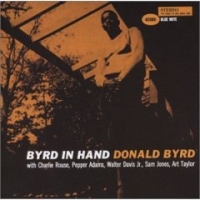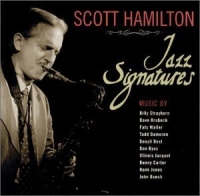Donald Byrd - Byrd In Hand (1959)
 As the five-star Down Beat review that this album garnered at the time of its release indicates, Ira Girler was not alone in feeling that Byrd In Hand represented a new plateau for its trumpet-playing leader. The session's inspired music represents the conjunction of several critic associations that brought Byrd into his most productive and influential period as a recording artist.
As the five-star Down Beat review that this album garnered at the time of its release indicates, Ira Girler was not alone in feeling that Byrd In Hand represented a new plateau for its trumpet-playing leader. The session's inspired music represents the conjunction of several critic associations that brought Byrd into his most productive and influential period as a recording artist. The most sustained and prolific of these relationships was the one Byrd shared with his old friend from Detroit, Pepper Adams. They had started working in New York and recording together a year earlier, and would continue to co-lead bands through late 1961. While Chet Baker and Gerry Mulligan had already displayed how well trumpet and baritone sax could blend in a small group, Byrd and Adams were clearly something else. The saxophonist, an acerbic dervish with a brawny tone who mixed streams of bebop and caustic quotes, was the perfect complement to Byrd's more thoughtful and tender inventions. This album, their third together and second on Blue Note (after Off to the Races), was the first to fully display the range of moods they were capable of producing. An excellent example is Byrd's haunting "Here Am I", with an atmospheric blend of vamp and melody so strong it was reprised almost verbatim two years later in Duke Pearson's composition "Say You're Mine", which was heard on another of Byrd's best Blute Note sessions, The Cat Walk.
A second important connection represented Byrd In Hand involves Thelonious Monk, a musician who is not even present. Four months before this session, Monk presented his first orchestral concert at New York's Town Hall by augmenting his working quartet (which included Charlie Rouse, Sam Jones and Art Taylor) with six additional musicians including Byrd and Adams. The Riverside album that the concert produced features strong playing from the trumpeter (a product perhaps in part of Monk's threat to replace Byrd with Lee Morgan when the former was late for a rehearsal), and Byrd was clearly satisfied enough with the experience to bring Monk's sidemen into his next project. Rouse, with his immediately identifiable sound and phraseology, is a delight here, and further complements the leader's warmth with his flinty inventions. The day after this session, Rouse, Jones and Taylor began work with their regular boss and Thad Jones on 5 By Monk By 5 of which the British critic Jack Cooke astutely observed that "The times were beginning to catch up with Monk... for a generation well versed in the search for fresh harmonic relationships through their experience of hard bop, and stimulated by that style's rhythmic devices, found themselves with a key to his music". Here we have more proof that Monk's aesthetic was spreading, even in the absence of his compositions.
For this reason, pianist Walter Davis Jr. was an ideal choice for the piano chair, given his friendship with Monk and Bud Powell. Davis was also in the midst of a period during which he collaborated frequently with Byrd. The two, plus Doug Watkins and Art Taylor, had traveled to and recorded in Europe during 1958. Upon their return, Davis began turning up on Blue Note sessions with Byrd, including Jackie McLean's New Soil (cut a month before this date) and his own Davis Cup (recorded two months later, with Jones and Taylor also present). While these albums gave the pianist far more solo space than he had enjoyed on his early recordings with Max Roach and Dizzy Gillespie, they were even more important in announcing Davis's talents as a composer. His writing here is notable in terms of both lyricism and structural originality. "Bronze Dance" shifts moods and meters seamlessly over a unique 28-bar chorus that allows Rouse to display his strong sense of contrast to particularly good effect, while the 44-bar form of "Clarion Calls" is handled by Adams and Byrd without strain. When Rouse gets confused during his "Clarion Calls" solo and stays on for four extra bars, Davis simply omits four bars of his own chorus and sustains a see-saw figure until he is sure that the structure is secure.
One additional point of comparison this album calls to mind involves Clifford Brown, whose influence on Byrd was receding here as Byrd establishes a deeper sense of his own personality. In this regard, the brisk yet relaxed trumpet solo on "The Injuns" should be heard next to Brown's more bravura 1953 reading of the tune on which it is based, "Cherokee", now available on Clifford Brown Memorial Album in the RVG series, from a sextet date that also finds Rouse in the tenor chair.

